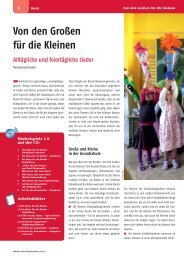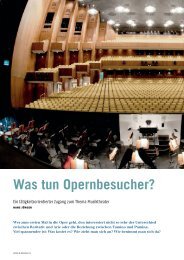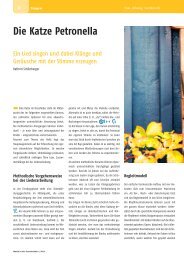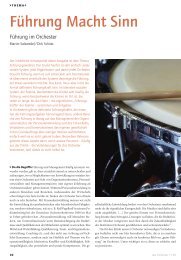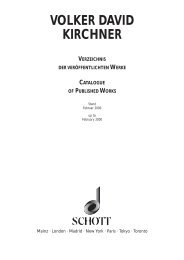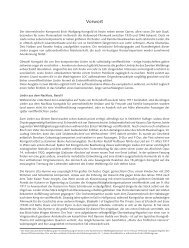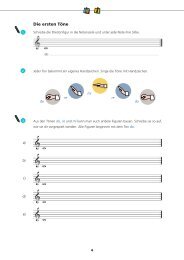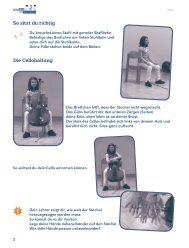HANS WERNER HENZE - Schott Music
HANS WERNER HENZE - Schott Music
HANS WERNER HENZE - Schott Music
Sie wollen auch ein ePaper? Erhöhen Sie die Reichweite Ihrer Titel.
YUMPU macht aus Druck-PDFs automatisch weboptimierte ePaper, die Google liebt.
E<br />
rstes Bild, Bahnhofshalle in einer französischen<br />
Stadt: Manon Lescaut, die auf dem Weg in ein<br />
Pensionat von ihrem Bruder Lescaut begleitet<br />
wird, trifft auf den Studenten Armand, der sie überredet,<br />
mit ihm zu gehen. · 2. Bild, Mansardenzimmer<br />
in Paris: Manon lebt glücklich mit Armand zusammen;<br />
dennoch lässt sie sich von Lescaut mit dem reichen<br />
Lilaque père verkuppeln. · 3. Bild, elegantes Boudoir<br />
bei Monsieur Lilaque: Lilaque überrascht Lescaut<br />
beim Diebstahl; er weist ihn und Manon aus dem<br />
Haus. · 4. Bild, Universitätsbibliothek: Manon trifft<br />
Armand wieder; ungeachtet seiner Enttäuschung über<br />
ihre Untreue will er wieder mit ihr zusammenleben. ·<br />
5. Bild, Kaschemme: Armand erliegt dem Drogenrausch;<br />
Lescaut verkuppelt Manon erneut, diesmal<br />
mit Lilaque fils. · 6. Bild, Vorzimmer und Schlafzimmer<br />
von Lilaque fils: Lilaque père überrascht Manon und<br />
Armand; Manon schießt Lilaque nieder. · 7. Bild, vor<br />
dem Gefängnis: Armand wartet auf Manon; sie geht<br />
an ihm vorbei, ohne Notiz von ihm zu nehmen.<br />
Eine am epischen Theater und am Film geschulte<br />
kühl-analytische Struktur der von sinfonischen Zwischenspielen<br />
episodenhaft miteinander verbundenen<br />
Szenen und eine radikale Abkehr vom sinnlichen Gefühlsüberschwang<br />
früherer Vertonungen des Stoffes<br />
(Auber, Massenet, Puccini) kennzeichnen Henzes<br />
erste abendfüllende Oper. Die Sinfonischen Zwischenspiele<br />
sind auch als eigenständiges Orchesterwerk<br />
Bestandteil des Konzertrepertoires vieler Orchester.<br />
(siehe S. 96)<br />
In Boulevard Solitude ist noch sehr viel Balletthaftes,<br />
so sehr, dass man sagen könnte,<br />
das Ganze ist ein Ballett, nur dass eben die Solisten<br />
nicht tanzen, sondern singen. Alle Nebenrollen<br />
sind getanzt, und der Chor ist ins Orchester verbannt.<br />
Die Wahl des Manon-Stoffes und die Form<br />
des Ganzen, in Zusammenarbeit mit Walter Jokisch<br />
und Grete Weil erarbeitet, schließlich die Bezeichnung<br />
„lyrisches Drama“ lassen durchblicken, dass es<br />
mir um die Darstellung meist ganz zarter erotischer<br />
Zustände, hauptsächlich allerdings Verzweiflungszustände,<br />
ging; weder konnte ich ganz ernste noch<br />
wirklich heitere Dinge bewältigen, der Ernst wurde<br />
dunkle Trauer und die Heiterkeit immer zur Satire<br />
oder Parodie. Es entstand trotzdem, vielleicht wegen<br />
dieser Einspurigkeit, eine bestimmte Wirkung,<br />
ein gewisser Reiz und eine bestimmte Atmosphäre.<br />
F<br />
“ “<br />
irst scene, a station concourse in a French town:<br />
Manon Lescaut, on her way to a boarding school<br />
accompanied by her brother Lescaut, makes acquaintance<br />
with the student Armand who persuades<br />
her to go with him · 2nd scene, a room in a garret<br />
in Paris: Manon is living contentedly with Armand,<br />
but allows herself to be paired off by Lescaut with the<br />
wealthy Lilaque père. · 3rd scene, Monsieur Lilaque’s<br />
elegant boudoir: Lilaque catches Lescaut in the process<br />
of stealing and banishes him and Manon from his<br />
house. · 4th scene, the university library: Manon encounters<br />
Armand once more; despite his disappointment<br />
at her faithlessness, he wishes them both to<br />
live together once more. · 5th scene, a shady tavern:<br />
Armand succumbs to the influence of drugs; Lescaut<br />
pairs off Manon once again, this time with Lilaque fils.<br />
· 6th scene, Lilaque fils’ dressing room and bedroom:<br />
Lilaque père takes Manon und Armand by surprise;<br />
Manon shoots Lilaque. · 7th scene, at the entrance to<br />
the prison: Armand waits for Manon, but she walks<br />
past without acknowledging him.<br />
Henze’s first full-length opera is characterised by a<br />
cool and analytical structure shaped by epic theatre<br />
and film consisting of episodic interlinked scenes interspersed<br />
by symphonic interludes and represents a<br />
radical renunciation of the sensual emotional ardour<br />
of earlier settings of this plot (Auber, Massenet and<br />
Puccini). The Symphonic interludes have been incorporated<br />
into the concert repertoire of numerous orchestras<br />
as an independent work (see p. 96)<br />
Numerous facets of ballet can be observed<br />
in Boulevard Solitude and it could even be<br />
suggested that the work is intrinsically a ballet, except<br />
for the fact that the soloists are singers and<br />
not dancers. All supporting roles are danced and the<br />
chorus is banished to the orchestra pit. The selection<br />
of the Manon story, its overall form which was<br />
created in collaboration with Walter Jokisch and<br />
Grete Weil and ultimately the categorisation of the<br />
work as a “lyrical drama” all reveal that my primary<br />
focus was chiefly directed at the representation of<br />
extremely tender erotic situations which are however<br />
for the most part also desperate situations; I<br />
was unable to harness either extremes of seriousness<br />
or cheerfulness: seriousness transformed itself<br />
into grief and hilarity into satire or parody. Nevertheless,<br />
a particular effect evolved, a certain charm<br />
and specific atmosphere, perhaps precisely due to<br />
this single-track approach.<br />
13



